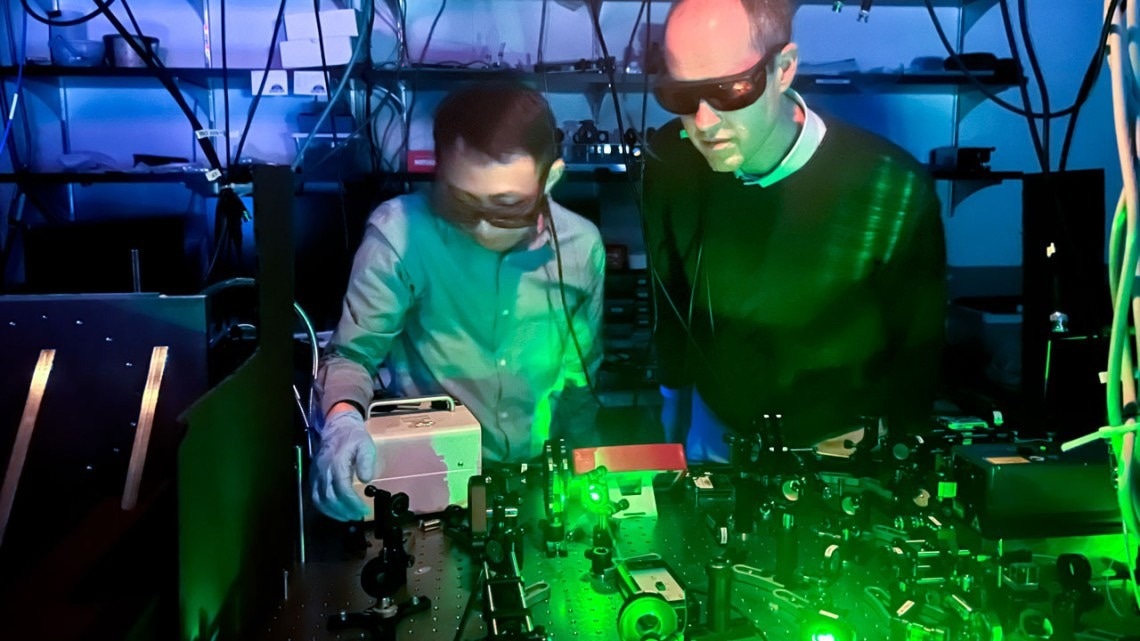Defects are a quantum sensor’s best friend in diamonds and other semiconducting materials.
 Doctoral student Jialun Luo (left) and Greg Fuchs, PhD ’07, Professor of applied and engineering physics at Cornell Engineering, searched for a “spin degree of freedom” in the popular semiconductor gallium nitride and found it, surprisingly, in two distinct species of defect. Image Credit: Charissa King-O’Brien/Cornell Engineering
Doctoral student Jialun Luo (left) and Greg Fuchs, PhD ’07, Professor of applied and engineering physics at Cornell Engineering, searched for a “spin degree of freedom” in the popular semiconductor gallium nitride and found it, surprisingly, in two distinct species of defect. Image Credit: Charissa King-O’Brien/Cornell Engineering
This is because electrons with angular momentum, or spin, that can store and process information can occasionally be found in defects, which are essentially an atom-by-atom arrangement. Many uses for this “spin degree of freedom” exist, including creating quantum networks and detecting magnetic fields.
Searching for such a spin in the widely used semiconductor gallium nitride, researchers led by Greg Fuchs, Ph.D. '07, Professor of Applied and Engineering Physics at Cornell Engineering, discovered it surprisingly in two different species of defect, one of which can be controlled for potential quantum applications.
The study was published in Nature Materials on February 12th, 2023. Jialun Luo, a Doctoral Candidate, is the main author.
Gems are also referred to as color centers because of their defects, which are what give them their color. For instance, nitrogen-vacancy centers, a type of defect, give pink diamonds their color. Even with widely used materials, there are still a lot of color centers that are unknown.
Gallium nitride, unlike diamond, is a mature semiconductor. It has been developed for wide bandgap high-frequency electronics, and that’s been a very intense effort over many, many years. You can go and buy a wafer of it, it’s in your computer charger, probably, or electric car. But in terms of a material for quantum defects, it has not been explored very much.
Greg Fuchs, Professor, Applied and Engineering Physics, Cornell Engineering
Fuchs and Luo joined forces with Doctorate Student Yifei Geng and Farhan Rana, the Joseph P. Ripley Professor of Engineering, with whom they had previously worked on the material to look for the spin degree of freedom in gallium nitride.
The team employed confocal microscopy to locate the defects using fluorescent probes, and they then carried out a variety of room-temperature experiments, including determining the variation in a defect’s fluorescence rate with a magnetic field and driving its spin resonant transmissions with a small magnetic field.
At the beginning, the preliminary data showed signs of interesting spin structures but we couldn’t drive the spin resonance. It turns out that we needed to know the defect symmetry axes and apply a magnetic field along the correct direction to probe the resonances; the results brought us more questions, waiting to be worked out.
Jialun Luo, Study Main Author and Doctoral Candidate, Cornell Engineering
The tests revealed that the material had two different kinds of defects, each with a unique spin spectrum. The spin was coupled to the ground state in one, and to a metastable excited state in the other.
In the latter instance, driving the spin transition allowed the researchers to observe fluorescence changes of up to 30%; this is a significant change, in contrast, and relatively uncommon for a quantum spin operating at room temperature.
Usually the fluorescence and spin are tied together very weakly, so when you change the spin projection, the fluorescence might change by 0.1%, or something very, very tiny. From a technology standpoint, that isn’t great, because you want a big change, so that you can measure it quickly and efficiently.
Greg Fuchs, Professor, Applied and Engineering Physics, Cornell Engineering
Next, a quantum control experiment was carried out by the researchers. The ground-state spin was discovered to be manipulable and to possess quantum coherence, which is the property that enables quantum bits, or qubits, to store information.
Fuchs says, “That’s something that is pretty exciting about this observation. There’s still a lot of fundamental work to do, and there’s many more questions than there are answers. But the basic discovery of spin in this color center, the fact that it has a strong spin contrast up to 30%, that it exists in a mature semiconductor material – that opens up all kinds of interesting possibilities that we now are excited to explore.”
The Materials Research Science and Engineering Center program of the National Science Foundation, the Cornell Engineering Sprout program, and the Quantum Sensing Challenges for Transformational Advances in Quantum Systems program of the NSF provided funding for the research conducted by the Cornell Center for Materials Research (CCMR).
The Cornell NanoScale Facility, which is additionally funded by the NSF, was utilized by the researchers.
Journal Reference:
Luo, J., et.al. (2024) Room temperature optically detected magnetic resonance of single spins in GaN. Nature Materials. doi.org/10.1038/s41563-024-01803-5.